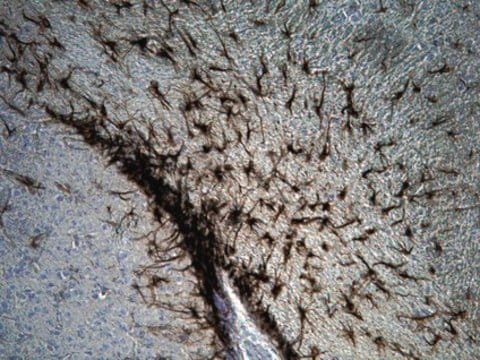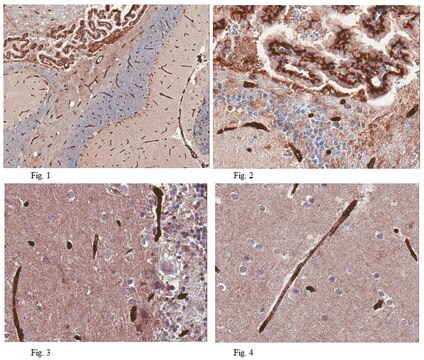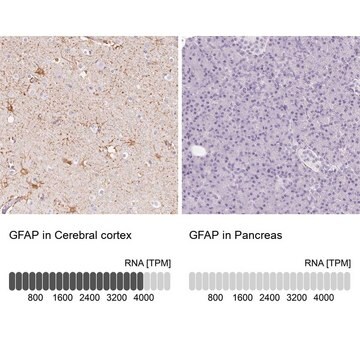추천 제품
종 반응성
rat, mouse, human
제조업체/상표
Chemicon®
assay range
sensitivity: 1.5 ng/mL
standard curve range: 1.5-100 ng/mL
기술
ELISA: suitable
NCBI 수납 번호
UniProt 수납 번호
검출 방법
colorimetric
유전자 정보
human ... GFAP(2670)
일반 설명
Background
Glial Fibrillary Acidic Protein (GFAP) is a class-III intermediate filament uniquely and ubiquitously expressed as part of the structural network in astrocytic glial cells. This specific expression makes GFAP ideal as a broad astrocytic marker in vertebrates. Astrocytes play a variety of key roles in supporting, guiding, nurturing, and signaling neuronal architecture and activity in a highly interdependent manner. Current understanding of CNS structure suggests that there are at least as many glial cells as the estimated 100 billion neurons, but perhaps upwards of 100 times more. Thus,
the health of both neurons and astrocytes is often affected in disease and trauma. GFAP is proving to be a useful biomarker in the detection of neural degeneration. Although defects in GFAP have been reported to cause certain rare conditions, such as Alexander’s disease (Brenner et al., 2001), the observed interconnected physiology of neuronal and glial cells has enabled the use of GFAP as a neurodegeneration detection gauge. This relationship is being exploited by researchers and clinicians measuring a variety of neurological issues from cancer to trauma. GFAP has been used as a biomarker in the early detection of chemically induced cancer (Capo et al., 1997) and classical glioblastomas (Jung et al., 2007). Elevated levels of GFAP have been reported in traumatic brain injury (TBI) and appear to directly correlate with the severity of injury and brain tissue oxygenation in combat casualty care research (CCR, 2008) as well as civilian accidents (Mondello et al., 2010). GFAP has also been identified as a good biomarker in studies of toxin induced acute brain injury (Liao et al., 2008), in differentiation of hemorrhagic vs. ischemic strokes (Foerch et al., 2006), as well as in cardiac arrest (Kaneko et al., 2009). Millipore now offers an ELISA assay for sensitive measurement of GFAP protein in tissue homogenates and biological fluids (serum, plasma, CSF, and serum free media) from human, mouse, and rat.
Principals of Procedure
This assay is a Sandwich ELISA based sequentially on: 1) capture of soluble GFAP protein to the wells of a microtiter plate coated by a pre-titered amount of anti-GFAP monoclonal antibody; 2) removal of unbound material by washing; 3) binding of biotinylated anti-GFAP monoclonal antibody to
the previously captured GFAP protein; 4) removal of unbound material by washing; 5) binding of streptavidin conjugated horseradish peroxidase to the biotinylated antibodies; 6) removal of excess or unbound enzyme conjugates by washing; and 7) quantification of immobilized antibody-enzyme
complexes by monitoring horseradish peroxidase activity in the presence of the substrate 3,3’,5,5’-tetramethylbenzidine (TMB). Enzyme activity is measured spectrophotometrically by recording absorbance readings at 450 nm. Increases in absorbency are directly proportional to the amount of
GFAP protein captured from the sample. Therefore the protein concentration of unknowns can be derived by interpolation using a standard curve generated in the same assay with reference standards of known concentrations of GFAP.
Glial Fibrillary Acidic Protein (GFAP) is a class-III intermediate filament uniquely and ubiquitously expressed as part of the structural network in astrocytic glial cells. This specific expression makes GFAP ideal as a broad astrocytic marker in vertebrates. Astrocytes play a variety of key roles in supporting, guiding, nurturing, and signaling neuronal architecture and activity in a highly interdependent manner. Current understanding of CNS structure suggests that there are at least as many glial cells as the estimated 100 billion neurons, but perhaps upwards of 100 times more. Thus,
the health of both neurons and astrocytes is often affected in disease and trauma. GFAP is proving to be a useful biomarker in the detection of neural degeneration. Although defects in GFAP have been reported to cause certain rare conditions, such as Alexander’s disease (Brenner et al., 2001), the observed interconnected physiology of neuronal and glial cells has enabled the use of GFAP as a neurodegeneration detection gauge. This relationship is being exploited by researchers and clinicians measuring a variety of neurological issues from cancer to trauma. GFAP has been used as a biomarker in the early detection of chemically induced cancer (Capo et al., 1997) and classical glioblastomas (Jung et al., 2007). Elevated levels of GFAP have been reported in traumatic brain injury (TBI) and appear to directly correlate with the severity of injury and brain tissue oxygenation in combat casualty care research (CCR, 2008) as well as civilian accidents (Mondello et al., 2010). GFAP has also been identified as a good biomarker in studies of toxin induced acute brain injury (Liao et al., 2008), in differentiation of hemorrhagic vs. ischemic strokes (Foerch et al., 2006), as well as in cardiac arrest (Kaneko et al., 2009). Millipore now offers an ELISA assay for sensitive measurement of GFAP protein in tissue homogenates and biological fluids (serum, plasma, CSF, and serum free media) from human, mouse, and rat.
Principals of Procedure
This assay is a Sandwich ELISA based sequentially on: 1) capture of soluble GFAP protein to the wells of a microtiter plate coated by a pre-titered amount of anti-GFAP monoclonal antibody; 2) removal of unbound material by washing; 3) binding of biotinylated anti-GFAP monoclonal antibody to
the previously captured GFAP protein; 4) removal of unbound material by washing; 5) binding of streptavidin conjugated horseradish peroxidase to the biotinylated antibodies; 6) removal of excess or unbound enzyme conjugates by washing; and 7) quantification of immobilized antibody-enzyme
complexes by monitoring horseradish peroxidase activity in the presence of the substrate 3,3’,5,5’-tetramethylbenzidine (TMB). Enzyme activity is measured spectrophotometrically by recording absorbance readings at 450 nm. Increases in absorbency are directly proportional to the amount of
GFAP protein captured from the sample. Therefore the protein concentration of unknowns can be derived by interpolation using a standard curve generated in the same assay with reference standards of known concentrations of GFAP.
애플리케이션
Research Category
Neuroscience
Neuroscience
Used to detect/quantify: GFAP
포장
96 wells
성분
96-Well Anti-GFAP Coated Plate (CS206352): 1 Plate
1X Assay Buffer (CS206357): 40 mL
10X Wash Buffer (CS206360): 50 mL
GFAP Protein Standard (CS206361): 1 Vial
GFAP Quality Control #1 (CS206351): 1 Vial
GFAP Quality Control #2 (CS206475): 1 Vial
Biotinylated Anti-GFAP Detection Antibody (CS206356): 12 mL
Enzyme Solution (CS206358): 12 mL
TMB Solution (CS202682): 10 mL
Stop Solution (60193): 12 mL
Plate Sealers (CS200443): 10 Sheets
1X Assay Buffer (CS206357): 40 mL
10X Wash Buffer (CS206360): 50 mL
GFAP Protein Standard (CS206361): 1 Vial
GFAP Quality Control #1 (CS206351): 1 Vial
GFAP Quality Control #2 (CS206475): 1 Vial
Biotinylated Anti-GFAP Detection Antibody (CS206356): 12 mL
Enzyme Solution (CS206358): 12 mL
TMB Solution (CS202682): 10 mL
Stop Solution (60193): 12 mL
Plate Sealers (CS200443): 10 Sheets
저장 및 안정성
Storage: The GFAP ELISA kit is shipped on ice and should be stored at 2-8°C upon arrival.
Stability: Kit components are stable for a minimum of 6 months from the date of receipt if stored and
handled as described above.
Stability: Kit components are stable for a minimum of 6 months from the date of receipt if stored and
handled as described above.
법적 정보
CHEMICON is a registered trademark of Merck KGaA, Darmstadt, Germany
면책조항
For research use only. Not for use in diagnostic procedures.
신호어
Warning
유해 및 위험 성명서
Hazard Classifications
Aquatic Chronic 2 - Eye Irrit. 2 - Met. Corr. 1 - Skin Sens. 1
Storage Class Code
8A - Combustible corrosive hazardous materials
시험 성적서(COA)
제품의 로트/배치 번호를 입력하여 시험 성적서(COA)을 검색하십시오. 로트 및 배치 번호는 제품 라벨에 있는 ‘로트’ 또는 ‘배치’라는 용어 뒤에서 찾을 수 있습니다.
자사의 과학자팀은 생명 과학, 재료 과학, 화학 합성, 크로마토그래피, 분석 및 기타 많은 영역을 포함한 모든 과학 분야에 경험이 있습니다..
고객지원팀으로 연락바랍니다.







